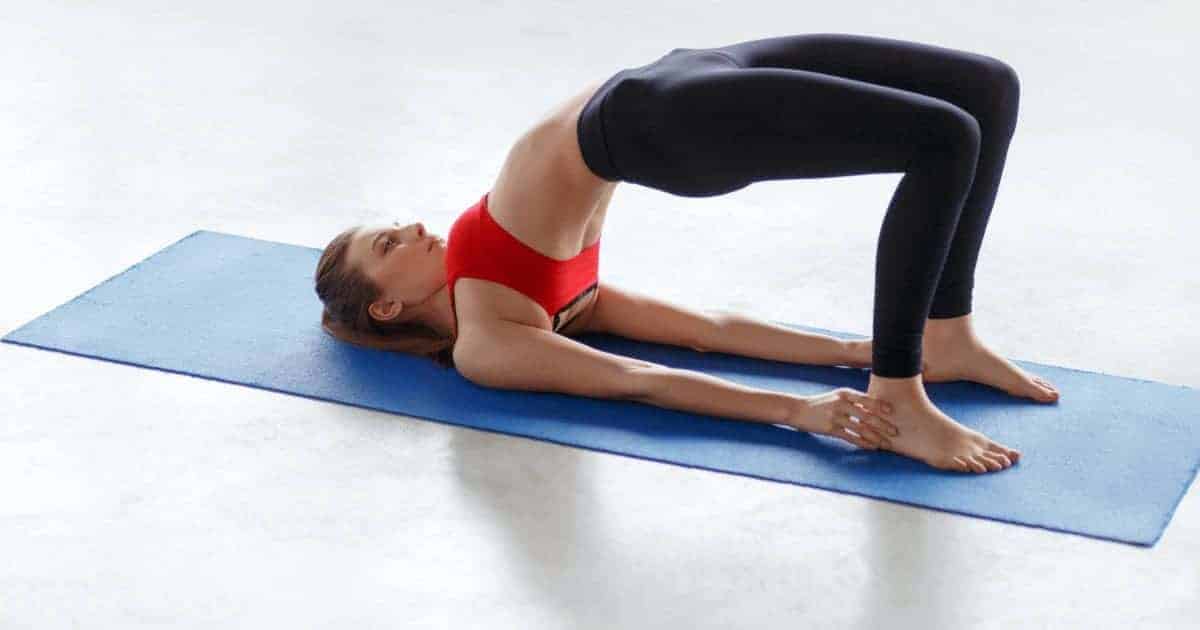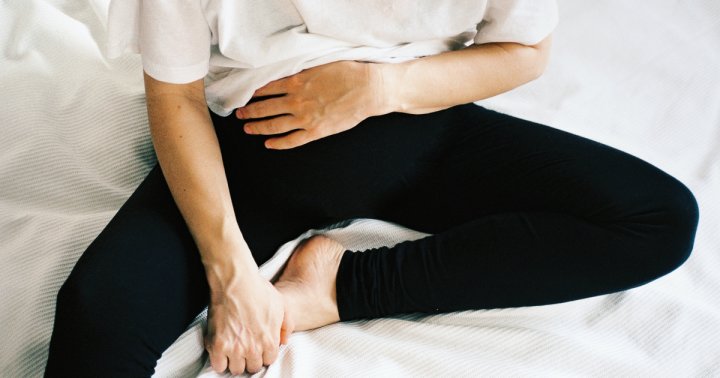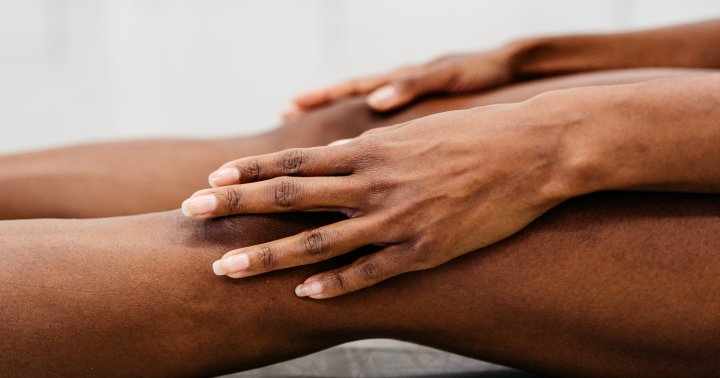The Most Beneficial Yoga Poses for Shoulder Blade Pain Relief
The post The Most Beneficial Yoga Poses for Shoulder Blade Pain Relief appeared first on The Yoga Nomads.

Are you looking for yoga poses to help relieve shoulder blade pain? The most effective poses to help with shoulder blade pain help stretch your upper back while opening up your shoulders and chest.
Dealing with shoulder blade pain can be debilitating at times. Luckily there are things you can do to lessen the pain like yoga that are not invasive.
Practicing yoga to help with shoulder blade pain relief is one of the best things you can do for recovery and pain management. Understanding the causes of your pain can also help you protect your shoulder blades from future injury.
Typical Causes of Shoulder Pain

Shoulder pain is not only uncomfortable, but it can also be inconvenient. Understanding the cause of your shoulder pain will give you the knowledge to help you target specific movements that will lessen the pain over time and keep you protected from any future shoulder pain. Shoulder pain is one of the most common reasons people seek out medical care for back pain.
The shoulders are a complex muscle group that have a variety of tendons and ligaments that can easily become inflamed causing pain and discomfort.
According to medical experts at Penn Medicine, when your shoulder blades are injured or causing pain it is most likely due to the tendons in your rotator cuff experiencing inflammation. If you feel like you often have tight shoulders your shoulder joints and tendons are likely inflamed.
So what causes these tendons to flair up? The main culprits are poor posture, overuse of the shoulder muscles, and incorrect lifting techniques.
Poor Posture is A Common Cause of Shoulder Blade Pain

One of the biggest culprits for pain in your shoulder blades is poor posture.
Keeping your back rounded throughout the day can cause tension to build over time which in turn causes your shoulder blades to ache.
While technology can add many benefits to life, it has also caused many individuals to lean over their computers or devices more throughout the day which negatively impacts posture over time.
When you are focused on the responsibilities of your everyday life, it can be hard to remember to think about your posture.
Your shoulder muscles are used more than you realize throughout the day. Reminding yourself to focus on sitting straight while also trying to relieve tension can help lessen pain in your shoulder blades over time.
How Yoga Helps Strengthen and Heal Shoulder Blades

Practicing yoga provides numerous benefits for different muscle groups. Many yoga poses naturally included a shoulder stretch which helps reduce muscle strain on your shoulder blades.
Yoga is often recommended as a form of therapy by medical professionals when working on nursing an injury back to health. Many people use yoga to help with chronic pain, specifically chronic upper back pain.
Yoga Works Multiple Muscles At Once
A unique aspect of yoga is that each pose provides a variety of benefits that positively impact numerous different muscle groups. For example, when you practice downward facing dog you are not only strengthening your shoulders, you are also stretching from your lower back to your hamstrings and then all the way down to your calves and heels too.
With yoga poses providing so many different benefits to a variety of muscle groups at once, even a few minutes of yoga a day can make a long-term impact over time when it comes to strength and flexibility.
This is good news for your shoulders and back muscles which will naturally strengthen over time the more you practice yoga.
The Important of Focusing On Breath When Practicing Yoga for Shoulder Blade Pain

Tension is one of the main culprits for pain in the body. Since stress can negatively impact your muscles and increase pain, being as relaxed as possible is important when practicing yoga.
As you are warming up to practice yoga, relaxing your body is paramount to reap all the rewards of yoga. The best way to relax your body is to focus on your breath.
Deep breathing naturally allows stress to exit the body and puts the body in a state of relaxation and calm.
In yoga, there is a term used to refer to breathing techniques called “pranayama”“. Pranayama translates to mean breath control.
Focusing on pranayama while practicing yoga allows the body to relax and stay present to experience all of the benefits that yoga has to offer.
Remember to Stabilize Your Core During Yoga Poses
As you are getting ready to begin a yoga practice, or even if you are simply trying out a few poses, stabilizing your core is crucial in yoga. You’ve now learned that many poses work multiple muscle groups at once but the core is the foundation for it all.
Before people enter into yoga poses, their back and shoulders are often tight and overworked. Stabilizing your core will help support these muscles and take some of the stress and tension away from other parts of the body as well.
With this interconnected muscle work, your core is what keeps you balanced and stable.
A stable core will also help you focus on releasing tension in other areas of your body such as your back and legs.
Which Yoga Poses Are the Most Beneficial for Shoulder Blades?

Whether you are new to practicing yoga or have years of experience, focusing on individual poses for your shoulder blades will help provide the pain relief you need.
With so many different yoga poses to try it can be hard to narrow down which ones specifically target your shoulder blades.
While many yoga poses will either help open your shoulders or strengthen them, there are specific poses that can help with pain relief.
Yoga experts suggest focusing on bridge pose, child’s pose, cat and cow pose, mountain pose, extended side angle pose, and cobra pose to help specifically with shoulder blades.
Benefits of Bridge Pose
One of the most commonly recommended yoga poses for shoulder pain is bridge pose. This pose is not only easily accessible, but it can also help reduce stress in the body and mind.
Bridge pose comes in different forms and is an easy pose to use to help release tension. When setting up for bridge pose, lie on your back with your feet flat on the mat and your knees bent.
Keep your hips shoulder distance apart. This pose is important to ease into in order to help prevent injury and allow your back muscles to open up gradually.
Once your feet are in line with your shoulders, gently lift your glutes off the mat, inhaling while you lift.
Stay lifted for 3-5 deep breaths then lower back down to the mat on an exhale. Repeat the pose, working to lift higher to get a deeper stretch.
Bridge pose will naturally open your chest and shoulder muscles, but it also helps to work your glutes and quad muscles too. Don’t forget to keep your core engaged to get the most out of this pose.
Release Tension With Child’s Pose

One of everyone’s favorite yoga poses is child’s pose. This upper body and hip opener brings space and pain relief to your upper back muscles, including your shoulder blades.
In order to release as much tension as possible when adjusting in this pose, make sure your upper body is wide enough to fit between your hips as you stretch.
As you stretch your arms out to the front of the mat take a deep breath in and then out. Releasing tension with your breath should allow you to take the stretch even deeper.
Cat and Cow Poses Help Open Your Chest
If you have ever been to a yoga class, the teacher has likely mentioned the importance of opposite movements.
Since one of the reasons that shoulder blades tend to cause pain is from having hunched shoulders due to poor posture, chest opening stretches can help to counteract contracted shoulders.
According to medical experts at HSS, this mindset of keeping things balanced with opposite movements is true in the medical field as well. When you are working to strengthen your back
muscles, experts advise focusing on strengthening chest muscles too.
Cat and cow pose starts with your hands and knees on the mat in a tabletop position. With your hips shoulder-width apart, arch your back into the cat position first.
Align Your Back Muscles with Mountain Pose
Many yoga teachers will often begin a pose sequence with mountain pose. Mountain pose is where you bring your feet together and pull down your shoulder blades together to help lengthen your spine.
This pose naturally encourages good posture and is a great pose to help retrain your brain to focus on standing firm and tall both on and off the mat.
Open Your Back with Extended Side Angle Pose

Any pose that focuses on lengthening the body will help open up your shoulder muscles. When practicing extended side angle pose, you are stretching out your entire upper back allowing for your shoulder joint to open.
To enter into side angle pose, step one foot forward into a lunge position. Once you are in a lunge, lean forward to place the arm of the front foot either balanced on the knee or with your palm flat on the ground.
With the opposite arm, extended your arm out as far as possible allowing your upper chest to stretch with it.
Make sure that if you started the pose with your left arm extended that you repeat the pose again on the opposite side to be able to extend your left arm.
Strengthen Your Back with Cobra Pose
Working on building your neck and shoulder muscles will help protect them from injury. Cobra pose allows you to focus on opening your chest while also gaining strength in your upper back.
In order to begin cobra pose lay flat on your stomach with your arms by your side. Bring your palms closer to the top of the mat and keep them flat. Your elbows should be hugged into the sides of your body.
On a deep inhale, slowly lift your neck straight off the mat. Make sure your back doesn’t round and is instead arched while your chest stays open.
As you practice yoga poses such as cobra pose more you will begin to notice both pain relief as well as muscle groups such as your upper back muscles strengthening.
How to Protect Your Shoulder Blades from Future Injury

Now that you have found yoga poses to help provide relief for upper back and shoulder blade pain, you may be wondering how to protect your shoulder blades for the future.
Remember that posture is a key issue that causes pain, so focusing on correcting bad posture is a great place to start.
Also, incorporating common shoulder stretches into your daily routine can be helpful to prevent future injury.
Frequently Asked Questions About Yoga For Shoulder Blade Pain

How Do You Relieve Shoulder Blade Pain?
When experiencing shoulder blade pain, one of the first things you should do is use ice or heat therapy to help relieve inflammation. Taking an anti-inflammatory medication can also be helpful in conjunction with heat or ice therapy.
Keep in mind that neck pain and shoulder pain can often go together, so make sure to keep your neck stretched and lengthened throughout the day.
Why Is My Shoulder Blade Hurting So Much?
Experiencing pain isn’t fun for anyone. When you are experiencing pain in your shoulder blade, it is likely caused by overuse or muscle strain.
If you have been having neck and shoulder pain it is possible that the pain is spreading to your shoulder blades as well. Sometimes even sleeping in a different position can cause shoulder blade pain, but that pain typically goes away faster than other causes.
How Do I Know If My Shoulder Blade Pain Is Serious?
It can be unsettling to experience shoulder blade pain, but keep in mind that most shoulder blade issues heal themselves over time. If you have been experiencing shoulder blade pain that has lasted more than a few weeks or you have lost a significant range of motion due to the pain then it is advised for you to seek out help from a medical professional.
Does Yoga Actually Help Shoulder Blade Pain?
The good news is the answer is yes, yoga absolutely helps relieve shoulder blade pain. In fact, yoga can actually lessen the intensity of your pain simply from the relaxation that the exercise provides.

 Hollif
Hollif 































.jpg&h=630&w=1200&q=100&v=f776164e2b&c=1)
